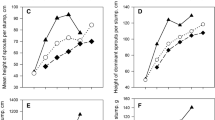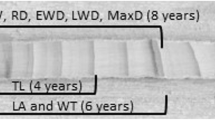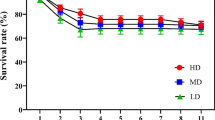Abstract
The competition-density effect for natural Japanese white bitch (Betula platyphylla var.japonica) stands, located in the northern part of Hokkaido Island, was examined for various growth stages to establish mean tree weight-density relationships over a considerable extent of stand growth of white birch. Aboveground yields of investigated stands ranged from 16.0 to 161.7 t·ha−1, and it was recognized that maximum aboveground yield of this species was about 160 t·ha−1. ConstantsA andB of the reciprocal equation of the C-D effect, 1/w=AN+B (w, mean tree weight; N, tree density), were related to mean height classes of birch stands. ConstantB was related to the entire mean height classes as the allometric relationship. On the other hand, constantA had an allometric relationship to mean height classes under 16 m, but became fixed over the 16 m class. White birch stands can come up to the maximum yield approximately at the stage of the 16 m class. The asymptotic tendency seemed to be appropriate for constantA-mean height class relationship. The maximum yield of white birch stands was predicted by the asymptotic value ofA. The trend of mean tree weight-density relationships with stand growth also changed with constantA. It was considered that maximum yield was an important characteristic for practical applications of the C-D effect to agriculture and forestry.
Similar content being viewed by others
References
Ando T. (1962) Growth analysis on the natural stands of Japanese red pine (Pinus densiflora Sieb et Zucc). II. Analysis of stand density and growth.Bulletin of the Government Forest Experimental Station, Tokyo 147: 45–77 (in Japanese with English summary).
Ando T. (1968) Ecological studies on the stand density control in even-aged pure stand.Bulletin of the Government Forest Experimental Station, Tokyo 210: 1–153 (in Japanese with English summary).
Bleasdale J. K. A. &Nelder J. A. (1960) Plant population and crop yield.Nature 188: 342.
Drew T. J. &Flewelling J. W. (1977) Some recent Japanese theories of yield-density relationships and their application to Monterey pine plantations.Forest Science 23: 517–534.
Firbank L. G. &Watkinson A. R. (1985) A model of interference within plant monocultures.Journal of Theoretical Biology 116: 291–311.
Firbank L. G. &Watkinson A. R. (1990) On the effects of competition: From monocultures and mixtures. In:Perspectives on Plant Competition (eds J. B. Grace & D. Tilman) pp. 165–192. Academic Press, San Diego.
Hatiya K. & Ando T. (1962) On the relations of the coefficients of the reciprocal equation to mean height.Transactions of the 73rd Annual Meeting of the Japanese Forestry Society: 164–168 (in Japanese).
Hozumi K. (1977) Ecological and mathematical considerations on self-thinning in even-aged pure stands. I. Mean plant weight-density trajectory during the course of self-thinning.The Botanical Magazine Tokyo 90: 165–179.
Katoh R., Segawa K. &Ohba S. (1965) Stand growth of birch stands in Kitakami mountain area. II. Biomasses and allometries in Japanese white birch stands in Hiraniwa area.Transactions of the Meeting in Tohoku Branch of the Japanese Forestry Society 18: 27–32 (in Japanese).
Kira T., Ogawa H. &Sakazaki N. (1953) Intraspecific competition among higher plants. I. Competition-yield-density interrelationship in regularly dispersed populations.Journal of the Institute of Polytechnics, Osaka City University Series D 4: 1–16.
Komiyama A., Higo M., Tanahashi M. & Ninomiya I. (1992) Studies on biomass estimation methods for deciduous broadleaved trees. (The report of a Grant-in-Aid for Scientific Research, No.02660155, from the Ministry of Education, Science and Culture of Japan) 144pp (in Japanese).
Miyajima H. (1961) Stand growth and physical characteristics of individual trees in a natural white birch stand regenerated after fire.Transactions of the Meeting in Hokkaido Branch of the Japanese Forestry Society 9: 67–71 (in Japanese).
Sato A., Ishizuka M., Sugawara S. &Toyooka H. (1986) Changes in the structure and the above-ground biomass of a youngBetula platyphylla var.japonica stand on a peat soil.Journal of the Japanese Forestry Society 68: 205–207 (in Japanese).
Shibuya M. &Matsuda K. (1993) Biomass estimations of aerial organs of natural white birch trees.Research Bulletin of the Hokkaido University Forests 50: 207–218 (in Japanese with English summary).
Shinozaki K. &Kira T. (1956) Intraspecific competition among higher plants. VII. Logistic theory of the C-D effect.Journal of the Institute of Polytechnics, Osaka City University Series D 7: 35–72.
Shinozaki K. &Kira T. (1961) The C-D rule, its theory and practical uses (Intraspecific competition among higher plants X).Journal of Biology, Osaka City University 12: 69–82.
Sotodate S. (1977) Biomass of a secondary forest dominated byBetula maximowiczii. Transactions of the 88th Annual Meeting of the Japanese Forestry Society: 257–258 (in Japanese).
Tadaki Y., Shidei T., Sakasegawa T. &Ogino K. (1961) Studies on productive structure of forest. II. Estimation of standing crop and some analyses on productivity of young birch stand (Betula platyphylla).Journal of the Japanese Forestry Society 43: 19–26 (in Japanese with English summary).
Takahashi Y., Asai T. &Kikuzawa K. (1974) On biomass estimation ofBetula platyphlla var.japonica forest stand in Nayoro.Bulletin of the Hokkaido Forest Experiment Station 12: 29–37 (in Japanese with English summary).
Watkinson A. R. (1980) Density-dependence in single-species populations of plants.Journal of Theoretical Biology 83: 345–357.
Watkinson A. R. (1984) Yield-density relationships: The influence of resource availability on growth and self-thinning in populations ofVulpia fasciculata.Annals of Botany 53: 469–482.
White J. (1980) Demographic factors in populations of plants. In:Demography and Evolution in Plant Populations (ed. O. T. Solbrig) pp. 21–48. Blackwell Scientific Publications, Oxford.
Yoda K., Kira T., Ogawa H. &Hozumi K. (1963) Self-thinning in overcrowded pure stands under cultivated and natural conditions (Intraspecific competition among higher plants XI).Journal of Biology, Osaka City University 14: 107–129.
Yoshimura K. &Hurumoto H. (1973) Studies on stand treatments for broad-leaved forests: On the primary productivities of white birch stands.Transactions of the Meeting in Hokkaido Branch of the Japanese Forestry Society 22: 93–96 (in Japanese).
Author information
Authors and Affiliations
About this article
Cite this article
Shibuya, M. Maximum yield and the C-D effects in natural white birch stands. Ecol. Res. 9, 325–332 (1994). https://doi.org/10.1007/BF02348419
Received:
Accepted:
Issue Date:
DOI: https://doi.org/10.1007/BF02348419




